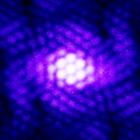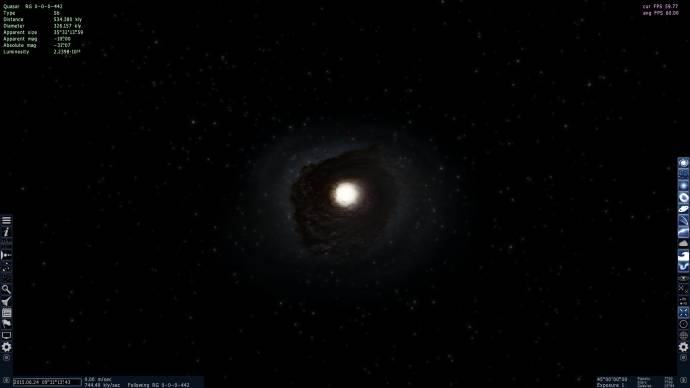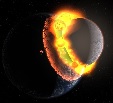|
Space anomalies
|
|
| Watsisname | Date: Tuesday, 01.12.2015, 03:10 | Message # 436 |
 Galaxy Architect
Group: Global Moderators
 United States
United States
Messages: 2613
Status: Offline
| You'd think, but no.  Remember you're looking at planets orbiting hundreds of AU away. The strength of tidal forces drops as the cube of the distance, so that far out, the tidal forces are totally negligible. Similar story with the radiation. This no worse of an environment for planet formation than where Earth formed. Remember you're looking at planets orbiting hundreds of AU away. The strength of tidal forces drops as the cube of the distance, so that far out, the tidal forces are totally negligible. Similar story with the radiation. This no worse of an environment for planet formation than where Earth formed.
I might have some concern over whether the supernova that created the black hole would vaporize the system, but I'm not certain. It would require doing some maths.
SpaceEngine is pretty accurate (though not perfect) in factoring all these things in during system generation; realism is one of the core goals with this program.

|
| |
| |
| LookAtDatDakka | Date: Tuesday, 01.12.2015, 04:32 | Message # 437 |
 Explorer
Group: Users
 United States
United States
Messages: 156
Status: Offline
| Quote TheGreatAttractor (  ) I found a quasar!!! 
I also found a quasar brighter than yours.

NVIDIA 960 GTX 2048MB
Edited by LookAtDatDakka - Tuesday, 01.12.2015, 04:33 |
| |
| |
| parameciumkid | Date: Tuesday, 01.12.2015, 19:01 | Message # 438 |
 Explorer
Group: Users
 United States
United States
Messages: 277
Status: Offline
| The galaxies in SE's universe are numbered in order of brightness, so the brightest quasar is bound to be something along the lines of RG 0-0-0-[small number]. I forgot whether or not I've seen it before and what exact number it is, but I'm pretty sure there's at least one with the last number below 100.
Intel HD Graphics 4000 ;P
|
| |
| |
| Alek | Date: Tuesday, 01.12.2015, 23:42 | Message # 439 |
 Pioneer
Group: Users
 United States
United States
Messages: 326
Status: Offline
| What galaxy is all 0's? Or at least only has a 1 at the end?
Living among the stars, I find my way. I grow in strength through knowledge of the space I occupy, until I become the ruler of my own interstellar empire of sorts. Though The world was made for the day, I was made for the night, and thus, the universe itself is within my destiny.
Edited by Alek - Tuesday, 01.12.2015, 23:43 |
| |
| |
| Watsisname | Date: Wednesday, 02.12.2015, 06:47 | Message # 440 |
 Galaxy Architect
Group: Global Moderators
 United States
United States
Messages: 2613
Status: Offline
| RG 0-0-0-0. It is an S0. 

|
| |
| |
| Watsisname | Date: Wednesday, 02.12.2015, 11:15 | Message # 441 |
 Galaxy Architect
Group: Global Moderators
 United States
United States
Messages: 2613
Status: Offline
| Quote Watsisname (  ) I might have some concern over whether the supernova that created the black hole would vaporize the system, but I'm not certain. It would require doing some maths.
I made some rough calculations. As I'd guessed, for planets within a few AU of a supernova, the intensity of the radiation is sufficient to completely vaporize and obliterate them. But a few AU is really close. That can even be inside the progenitor star.
At hundreds of AU, it's a different story, and this is where I could not trust my intuition. Supernovae are incredibly bright, but 100AU is also very far. It turns out that at this distance, the radiation is intense enough to melt rock and even iron, so it would be devastating to planetary atmospheres and surfaces. However, the total energy delivered is orders of magnitude less than what is necessary to vaporize a whole planet, and it is also less than the gravitational binding energy of a planet (whether Earth-like or a gas giant).
There is also the question of the energy delivered by the shockwave. The shockwave is very fast, but a planet that far out doesn't intercept much material. "Much" being maybe about the mass of an asteroid. Still not enough energy.
So, that was some cool knowledge gained. Supernovae are unbelievably energetic events. But planets in the system can survive them, if they are far enough away. That seems to be consistent with the fact that we've detected planets orbiting pulsars, though we don't necessarily know if those planets formed before or after the supernova that created the pulsar.

|
| |
| |
| Alek | Date: Thursday, 03.12.2015, 03:00 | Message # 442 |
 Pioneer
Group: Users
 United States
United States
Messages: 326
Status: Offline
| Quote Watsisname (  ) That seems to be consistent with the fact that we've detected planets orbiting pulsars, though we don't necessarily know if those planets formed before or after the supernova that created the pulsar.
I don't think we have the tech to detect planets around any star that far away--In fact, the first exoplanets discovered were around a pulsar, so those probably came after the supernova; the star they would've been orbiting before the supernova would've ended up being inside the star and then vaporized in the supernova. Don't think there'd be much chance for them to survive that.
Living among the stars, I find my way. I grow in strength through knowledge of the space I occupy, until I become the ruler of my own interstellar empire of sorts. Though The world was made for the day, I was made for the night, and thus, the universe itself is within my destiny.
|
| |
| |
| Watsisname | Date: Thursday, 03.12.2015, 06:19 | Message # 443 |
 Galaxy Architect
Group: Global Moderators
 United States
United States
Messages: 2613
Status: Offline
| Oh, I thought some of them were discovered in larger orbits, but you're right. All pulsar planets detected thus far orbit too close (with maybe one exception, but we think it has a separate evolutionary history for other reasons) . There's also the problem of the sudden loss of much of the system's mass during the supernova, which will usually cause any surviving planets to be ejected.
The case of massive binaries, such as RS 9173-4040-0-0-5 here, is a really interesting one. There the planets may be distant enough to survive, and the combination of star masses might also help survivors to remain bound.

|
| |
| |
| axeladalidez78 | Date: Thursday, 03.12.2015, 15:00 | Message # 444 |
 Observer
Group: Users
 Spain
Spain
Messages: 12
Status: Offline
| I just found the most weirdest Titan , It has exotic and Organic life , it's the first time I found this. Is this very rare?
Here is the Image
Intel Core i5-4460s 2.90ghz , 8gbRAM , Intel core HD Graphics 4000 , AMD Radeon r5 330
Edited by axeladalidez78 - Thursday, 03.12.2015, 15:04 |
| |
| |
| Donatelo200 | Date: Thursday, 03.12.2015, 16:37 | Message # 445 |
|
Explorer
Group: Users
 United States
United States
Messages: 261
Status: Offline
| Very rare indeed. Nice find!
CPU: Intel Core i7-4790K
GPU: Nvidia GTX 1080
SSD: Samsung 850 Evo 250GB
HDD: Toshiba DT01ACA200 2TB
HDD: WD Blue 1TB (2012)
RAM: Unknown 16G-D3-1600-MR 2x8GB
MBD: MSI Z97S SLI Krait Edition (MS-7922)
|
| |
| |
| LookAtDatDakka | Date: Friday, 04.12.2015, 02:57 | Message # 446 |
 Explorer
Group: Users
 United States
United States
Messages: 156
Status: Offline
| Quote axeladalidez78 (  ) I just found the most weirdest Titan , It has exotic and Organic life , it's the first time I found this. Is this very rare?
Here is the Image
It looks similar to Earth. Also, I found a two gas giants tidally locked to each other.
Barycenter: RS 0-0-0-442-28712-8-4104776-52 10-10.1
NVIDIA 960 GTX 2048MB
Edited by LookAtDatDakka - Sunday, 06.12.2015, 21:48 |
| |
| |
| GlenStevensTD | Date: Friday, 04.12.2015, 18:22 | Message # 447 |
|
Observer
Group: Banned
 Belgium
Belgium
Messages: 11
Status: Offline
| Temperate Terra with life around red dwarf late M-class without tidally locked
Location: RS 0-1-5-333-2267-9-57521118-1408 A3
Version: 0.9.7.4 Beta 7 patch
Pictures:


Frozen Titan with life around red dwarf M-class with blue atomsphere on the night
Location: RS 0-5-25161-821-3929-7-1359483-314 B8.5
Version: 0.9.7.4 Beta 7 patch
Pictures:


Edited by GlenStevensTD - Friday, 04.12.2015, 18:23 |
| |
| |
| steeljaw354 | Date: Friday, 11.12.2015, 11:44 | Message # 448 |
 World Builder
Group: Users
 Pirate
Pirate
Messages: 862
Status: Offline
| Not all m dwarf planets are locked in real life, a very big asteroid could have struck the planet and it rotates, it could have a big moon that stableizes it's rotation and prevents it from being tidally locked.
|
| |
| |
| NickWaterfall | Date: Tuesday, 15.12.2015, 07:30 | Message # 449 |
|
Space Tourist
Group: Users
 Norway
Norway
Messages: 23
Status: Offline
| Quote parameciumkid (  ) The galaxies in SE's universe are numbered in order of brightness, so the brightest quasar is bound to be something along the lines of RG 0-0-0-[small number]. I forgot whether or not I've seen it before and what exact number it is, but I'm pretty sure there's at least one with the last number below 100.

The X-axis is the number in RG-0-0-0-X
As you can see, brightness goes up and down and doesn't seem to sink from galaxy #1 to #50, it's not sorted by brightness.
|
| |
| |
| Brett001 | Date: Thursday, 17.12.2015, 17:22 | Message # 450 |
 Space Pilot
Group: Users
 Hungary
Hungary
Messages: 84
Status: Offline
| Hot gas giant 421 C° 41.9 AU distance from the parent star? This is inner heating?
Edited by Brett001 - Thursday, 17.12.2015, 17:25 |
| |
| |